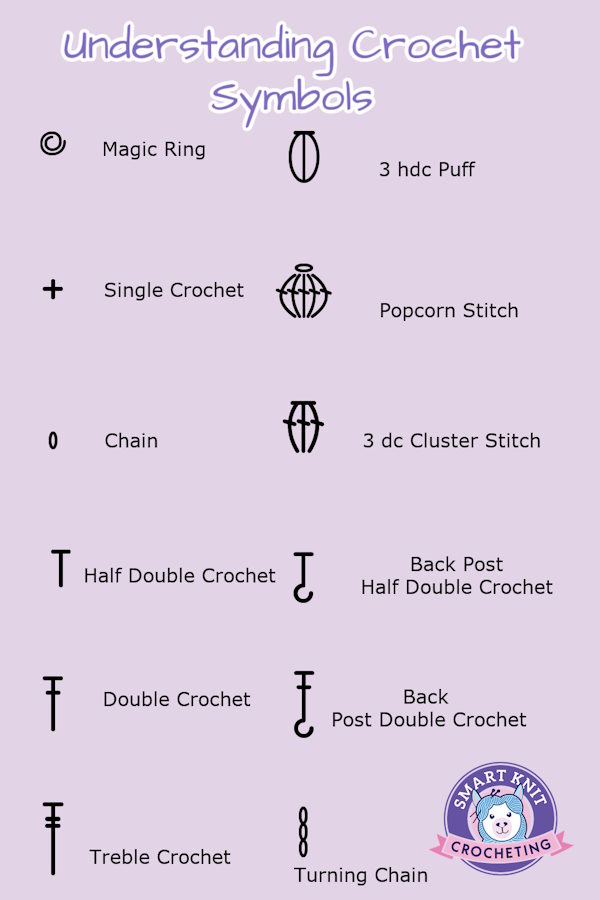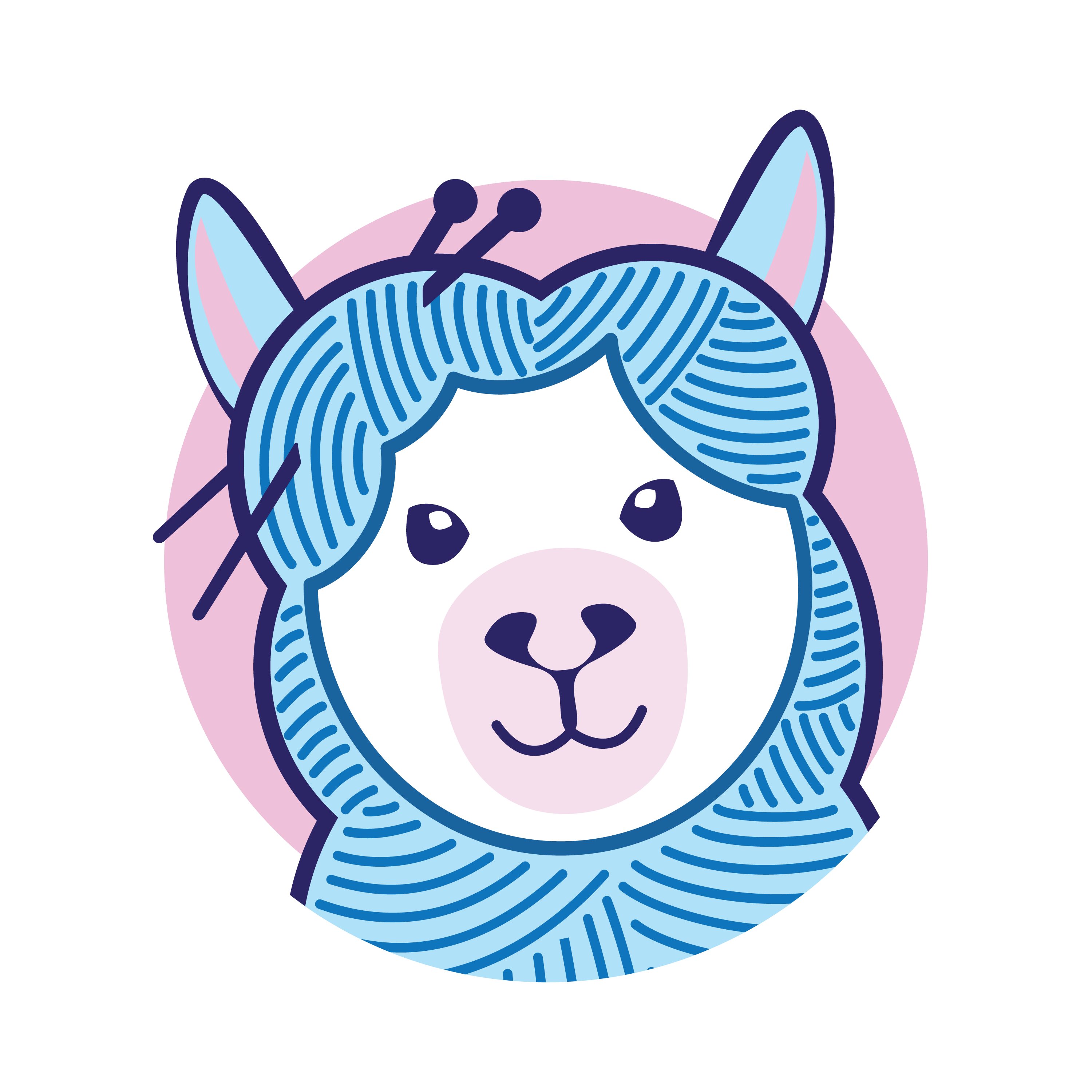- Home
- How to Crochet
- Understanding Crochet Symbols
Understanding Crochet Symbols: Plus How to Read and Use
Understanding Crochet Symbols by Janice Jones
If you're new to crochet, you may have already met the vast universe of crochet patterns. While this is a good thing, trying to understand all of them may seem overwhelming to beginners.
Written instructions are common, but many patterns also use a system of symbols to convey stitches and techniques efficiently in the form of a picture or diagram. That is where understanding crochet symbols comes into play.
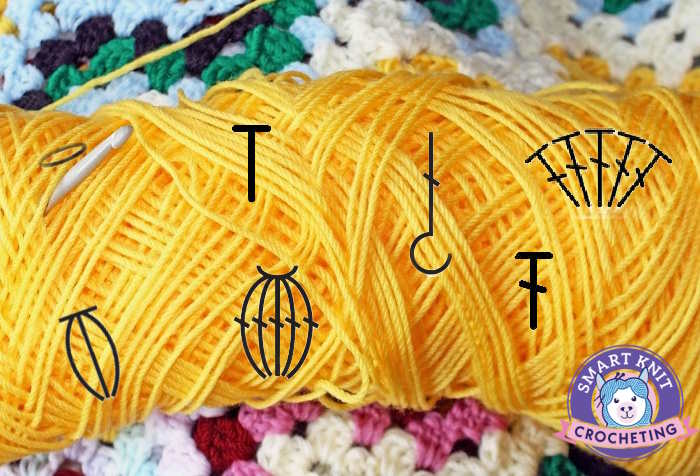 Understanding Crochet Symbols
Understanding Crochet SymbolsThese amazing symbols may look like some ancient hieroglyphics, once understood, these symbols
can make following a crochet pattern easier to read and visualize. They may even become your friend. In this guide, I will help you understand crochet symbols, starting with their historical roots, the anatomy, and how to read them.
Before we get into understanding crochet symbols, I must note that the stitches and instructions on this page are all in US terms. There are some differences between UK and US terminology.
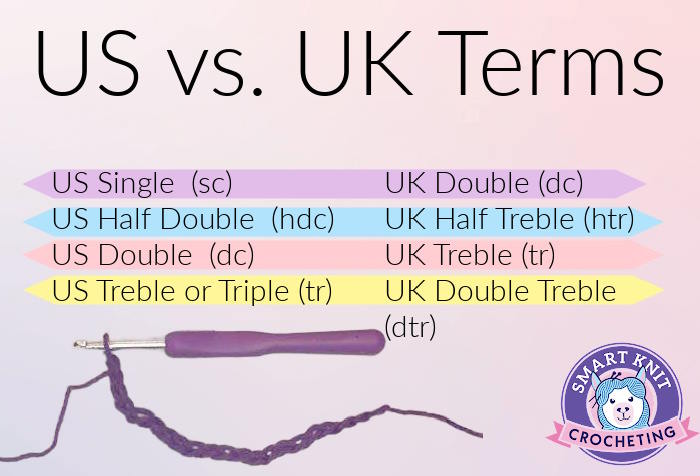
What Are Crochet Symbols?
Crochet symbols are graphic representations of stitches used in charted diagrams to illustrate how to complete a crochet project.
Each symbol corresponds to a specific crochet stitch, technique, or instruction. Charts containing these symbols are like visual maps that guide you through the pattern.
Even though they may not have any meaning to you now, you will be an expert by the time you finish reading this post.
Why Learn Crochet Symbols?
- Universal Language: Crochet symbols break language barriers, making international patterns accessible.
- Visual Aid: They represent stitches, which can be easier to follow than written instructions.
- Complex Patterns: Charts make understanding stitch placement and pattern repetition easier for intricate designs.
- Perfect for Visual Learners: If you are a visual learner, this is the way to go: Once you understand the anatomy of the crochet symbol, you will understand that each symbol looks like the stitch it stands for. Crochet diagrams are a visual representation of the finished fabric.
How Long Have Crochet Symbols Been Around
The history of crochet symbols is an interesting journey that parallels the development and globalization of crochet. Here’s an overview of how these symbols came into being and evolved.
19th Century: Illustrations
The origins of crochet symbols can be traced back to the 19th century when crochet began gaining popularity, particularly in Europe. Written instructions were the norm, and they were often lengthy and convoluted.
Patterns included detailed descriptions of each stitch and its placement, making simple designs cumbersome.
Early pattern books sometimes included illustrations to support written instructions. These illustrations were not yet standardized but helped beginners visualize the process. However, they were still relatively rudimentary and not widely adopted.
This is likely the reason why people relied on family, friends and neighbors for hands-on learning.
Mid-20th Century: International Crochet Symbols
The mid-20th century saw increased efforts to standardize crochet terminology and symbols. This period marked the beginning of a more formalized approach to crochet instructions.
Crochet became more popular globally, and the need for a universal language grew.
Organizations such as the Craft Yarn Council of America (later the Craft Yarn Council) started working on standardizing crochet terms and symbols.
European crochet patterns, particularly from countries like Japan and Russia, began incorporating symbols more extensively. These patterns reached a global audience, needing a standard notation system.
1970s and 1980s: Development of Modern Symbols
During this time, Japanese crochet books and magazines significantly developed and popularized crochet symbols. Japanese publishers were some of the first to embrace symbol-based patterns, which were clear and concise, making it easier to follow intricate designs.
Efforts to create an international standard for crochet symbols gained momentum. The International Organization for Standardization (ISO) introduced standardized symbols for crochet stitches, furthering the push for a universal system.
1990s and 2000s: Technological Influence
The Internet revolution helped spread crochet patterns and symbol charts worldwide. Countries that traditionally relied on written instructions began adopting symbol charts. Global crochet communities refined and popularized these symbols, creating a more cohesive and widely understood system.
The rise of digital patterns, online tutorials, and apps brought about greater uniformity in symbol usage. Software like Adobe Illustrator enabled designers to create clean, scalable diagrams, making it easier to produce professional-quality symbol charts.
Current State
Today, crochet symbols are an integral part of the craft and are used in patterns worldwide. The symbols have been largely standardized, though slight variations may still exist depending on regional or publisher-specific practices.
The continued efforts of organizations, designers, and crochet enthusiasts ensure that this visual language is still clear and accessible.
Understanding Crochet Symbols
Each basic crochet stitch has a corresponding symbol. Here are a couple examples of those basic stitches.
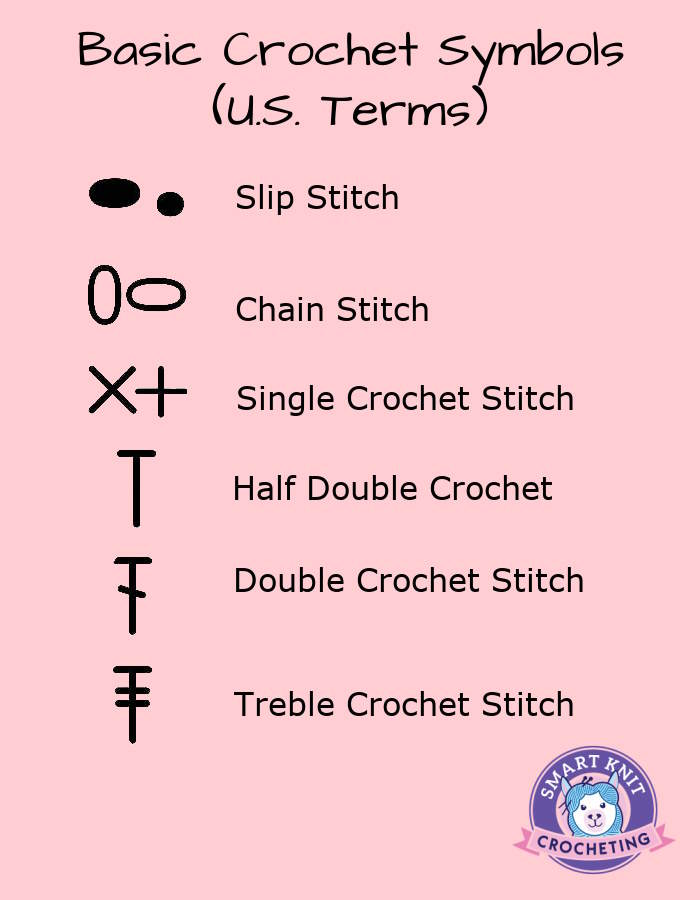
Beyond Understanding Crochet Symbols: Examining the Anatomy
When I think about the word, anatomy, I think back to high school biology, but here we are examining the different parts of a symbol.
Each symbol can tell you many things if you know what to look for.
- The number of turning chains for each row.
- How to make the stitch (back or front post double crochet)
- Whether to increase or decrease stitches (example: dc3tog)
- Where to make the stitch (work in back or front loop only)
- How to make clusters, puffs, popcorn stitches and others
Studying the Anatomy, Step-by-Step
Let's start with the double crochet stitch. What can this symbol reveal to us? Here are two versions of the double crochet stitch symbols. Both mean the same thing. We know that it is the double crochet because we can see
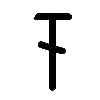 Double Crochet Symbol
Double Crochet Symbol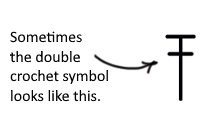 Double Crochet Stitch Symbol
Double Crochet Stitch Symbol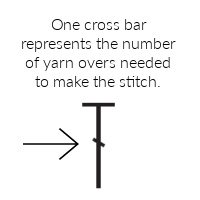
Work in Front or Back Loop Only
Next, let's look what we can do with that same double crochet stitch symbol. If the pattern wants us to work in the front or back loop only, these symbols will appear at the base of the symbol.
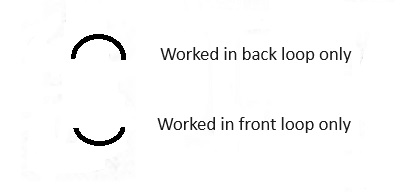
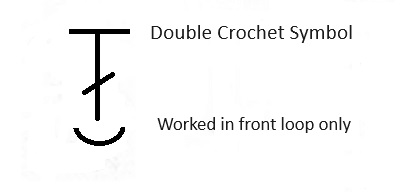
Post Stitches
We know that the double crochet stitch can be a front post only (FPdc) or back post double crochet (BPdc). This is how these stitches would appear in symbol form.
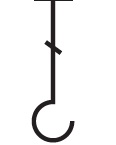 Back Post Double Crochet Symbol
Back Post Double Crochet Symbol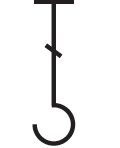 Front Post Double Crochet Symbol
Front Post Double Crochet SymbolIncreases and Decreases (Double Crochet Stitch)
There are symbols that tell us when to increase and decrease and how many to make.
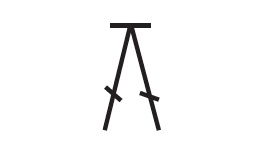 Double Crochet 2 together (DC2tog)
Double Crochet 2 together (DC2tog)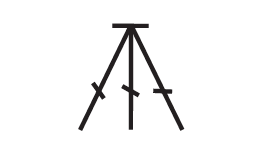 Double Crochet 3 together (dc3tog)
Double Crochet 3 together (dc3tog)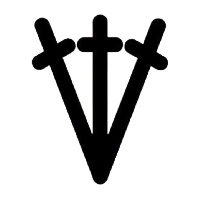 3 Double Crochet Increase
3 Double Crochet Increase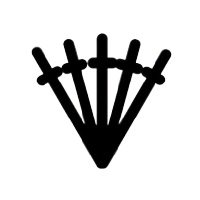 5 Double Crochet Increase
5 Double Crochet IncreaseMore Speciality Double Crochet Stitches
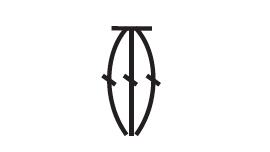 3 Double Crochet Cluster
3 Double Crochet Cluster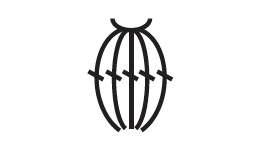 5 Double Crochet Popcorn
5 Double Crochet Popcorn 5 Double Crochet Shell Stitch
5 Double Crochet Shell StitchUnderstanding Crochet Symbols: More Stitch Pattern Symbols to Know
We've looked at how double crochet stitch symbols look, but that is only the beginning. There are many more. Other basic stitches such as single, half double, and treble stitches can be combined as you saw with the double crochet. Here are a couple more basic symbols you will encounter frequently.
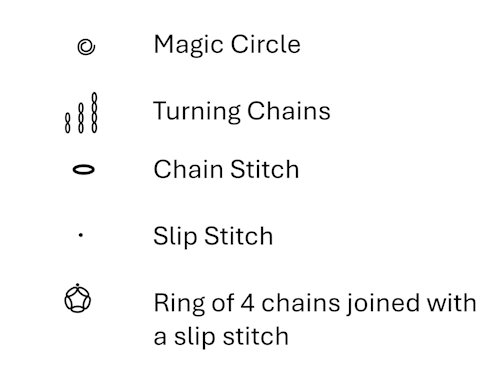
Understanding Crochet Symbols in Charts
Most crochet charts show symbols worked in either rows or in the round. The first chart is fictional. I doubt that you'd find it in any pattern, but I want to make one that is easy to understand.
Crochet Chart for a Fictitious Pattern
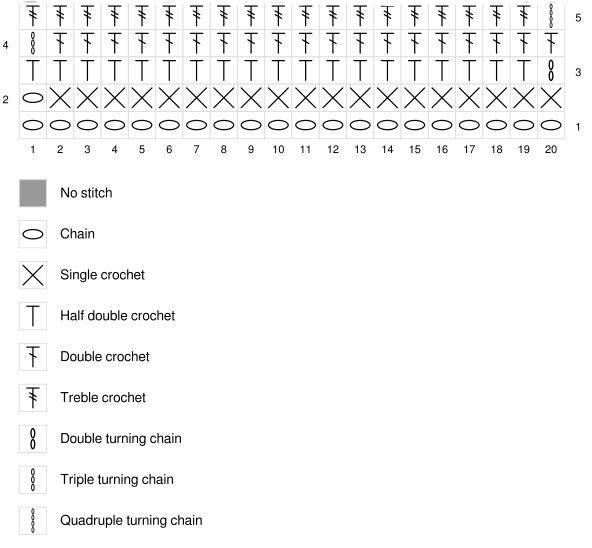
Written Instructions
For more information on the abbreviations used in these written instructions, jump to my page on crochet abbreviations.
In written form, this would look like this:
Ch. 21.
Row 1: Sc across row. Ch. 2 and turn.
Row 2: Hdc across row. Ch 3 and turn.
Row 3: Dc across row. Ch 4 and turn.
Row 4: Tr across row.
Repeat rows 1 - 4 for pattern.
This would be an unusual pattern, but it does show what a crochet chart looks like when using crochet symbols.
Understanding crochet symbols is also very important when working in the round.
Crochet Chart for Traditional Granny Square
This is a traditional granny square pattern. Look at the very middle of the chart. This one starts with four chain stitches and connected with a slip stitch. The only other stitches in this chart are single and double crochet stitches and chain stitches. Take a look and see if you can identify the different parts of the chart.
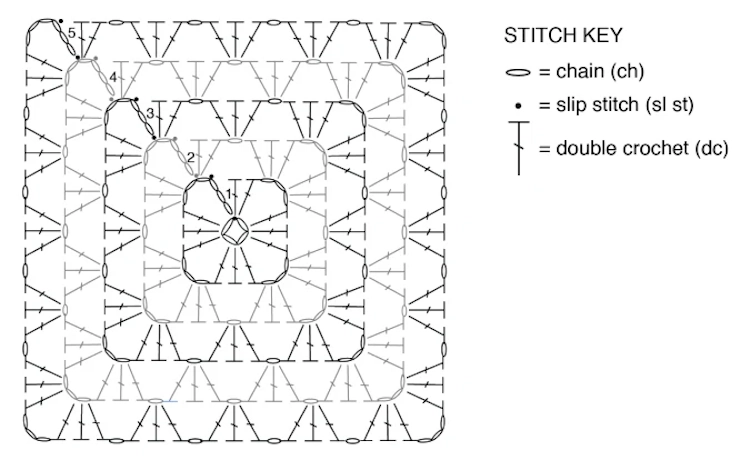 Traditional Granny Square Crochet Chart courtesy of Red Heart Yarn
Traditional Granny Square Crochet Chart courtesy of Red Heart YarnWritten Instructions
Ch 4, Join with a sl st to the first ch to form a ring.
1st round: Ch 6 (3 dc, 3 ch) 3 times in ring. 2 dc in ring. Join.
2nd round: Sl st in ch-3 space. Ch 6. 3 dc in same ch-3 sp. *Ch 1 (3dc, 3 ch, 3 dc) in next ch-3 space. Repeat from * twice more. Ch 1, 2 dc in first ch-3 sp. Join.
3rd round: Sl-st in Ch-3 sp. Ch 6, 3 dc in same ch-3 sp. *Ch 1, 3 dc in next Ch-3 space. Repeat from * twice more. Ch 1, 3 dc in last ch-1 sp. Ch 1. 2 dc in first Ch-3 sp. Join.
4th and 5th rounds: Sl st in ch-3 space. Ch 6, 3 dc in same Ch-3 sp. *(Ch 1, 3 dc) in each Ch-1 sp to next Ch-3 sp. Ch 1. *(3 dc, ch 3, 3 dc) in next ch 3 sp. Rep from * twice more, then from *to **once, 2 dc in first ch-3 sp. Join. Fasten off.
Conclusion
Understanding crochet symbols is a skill that most beginners need to learn at some point. As patterns get more complicated, a picture or chart makes instructions easier to understand. Charts are especially beneficial for visual learners.
Symbols are not hard to understand if you break them down into their parts. You may feel as though you need to memorize these symbols, but that is not necessary as most charts also come with a key and most stitches can be deciphered by remembering those "anatomy" lessons.
So grab some yarn and a hook and practice some stitches using crochet symbols.
Understanding Crochet Symbols: Pin for Future Reference
